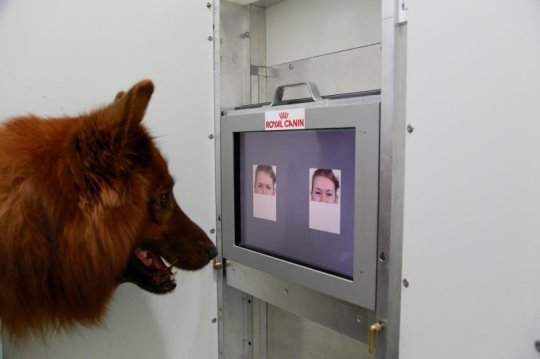Inspirational
Your Dog Understands your Facial Expressions

A recent study has shown scientists that dogs are similar to humans in how they recognize the emotions expressed in facial expressions. Dogs prefer to look us in the eyes and depending on our facial expression they will know if we are happy, threatening or content.
Though dogs combine their senses in order to understand what we are feeling this is the first time that scientists have noticed that a species other than humans can read faces. This isn’t news to those of us that spend a great deal of time with animals but it is still important that scientists are starting to recognize these facts because it will aid in the animal right movement.

This is the experimental set-up used to test whether dogs can discriminate emotional expressions of human faces.
Credit: Anjuli Barber, Messerli Research Institute
According to the new study published in the Cell Press journal Current Biology dogs can tell a big difference between when humans are feeling happy and when they are angry. The discovery is being called the first ‘solid evidence’ that an animal other than human can tell the difference between the emotional expressions of another species.
“We think the dogs in our study could have solved the task only by applying their knowledge of emotional expressions in humans to the unfamiliar pictures we presented to them,” says Corsin Müller from the University of Veterinary Medicine Vienna.
In the past attempts were made to help prove that dogs could understand our facial expressions but there were issues with the studies that left room for doubt. In this new study, however, the dogs were trained to observe the same person making different facial expressions such as angry and happy faces. The dogs were then able to accurately select what emotion was being displayed on the person’s face.
“Our study demonstrates that dogs can distinguish angry and happy expressions in humans, they can tell that these two expressions have different meanings, and they can do this not only for people they know well, but even for faces they have never seen before,” says senior author Ludwig Huber, from the University of Veterinary Medicine Vienna’s Messerli Research Institute.
Although the researchers are still not convinced that the dogs are feeling empathically with us they do react to the expressions accurately.
“… it appears likely to us that the dogs associate a smiling face with a positive meaning and an angry facial expression with a negative meaning.”
Müller and Huber also reported that they had a hard time tricking the dogs into seeing the negative face as one that would give them a reward. They believed this was because of previous experience that the dogs had with people who looked angry.
Dogs are quick to learn and adapt based on their experiences and the researchers believe that is a big factor in how the dogs react to the emotions of their human friends.
“We expect to gain important insights into the extraordinary bond between humans and one of their favorite pets, and into the emotional lives of animals in general,” Müller says.
Both Horses and humans use facial expressions to Communicate
Dogs aren’t the only ones who seem to respond to or use facial expressions. According to a study from the University of Sussex, horses express their emotions using facial expressions much like chimps or humans.
Just like humans, horses have intricate muscles in their faces around their eyes, lips and nostrils which they use to express a variety of emotions depending on the situation.
Previous research shows us that facial cues are very important in how horses communicate. The more recent study was able to identify 17 unique expressions from horses. This is compared to the 27 unique expressions in humans, 16 in dogs and 13 in chimps.
Researcher Jennifer Wathan, said: “Horses are predominantly visual animals, with eyesight that’s better than domestic cats and dogs, yet their use of facial expressions has been largely overlooked. What surprised us was the rich repertoire of complex facial movements in horses, and how many of them are similar to humans.
“Despite the differences in face structure between horses and humans, we were able to identify some similar expressions in relation to movements of the lips and eyes.
“What we’ll now be looking at is how these expressions relate to emotional states.”
In addition to anatomical investigations, a wide range of video footage featuring horses was analysed to identify the facial expressions and compare them to other horses exhibiting the same behavior.
Professor Karen McComb said: “It was previously thought that, in terms of other species, the further away an animal was from humans, the more rudimentary their use of facial expressions would be.
“Through the development of EquiFACS, however, it’s apparent that horses, with their complex and fluid social systems, also have an extensive range of facial movements and share many of these with humans and other animals. This contributes to a growing body of evidence suggesting that social factors have had a significant influence on the evolution of facial expression.”
She added that a systematic way of recording facial expressions would have a wide range of uses. “With EquiFACS we can now document the facial movements associated with different social and emotional contexts and thus gain insights into how horses are actually experiencing their social world. As well as enhancing our understanding of social cognition and comparative psychology, the findings should ultimately provide important information for veterinary and animal welfare practices.”
Research in this area will help raise awareness for animal rights as well as help us connect better with our animals friends.
Sources-
Typos, corrections and/or news tips? Email us at Contact@TheMindUnleashed.com


